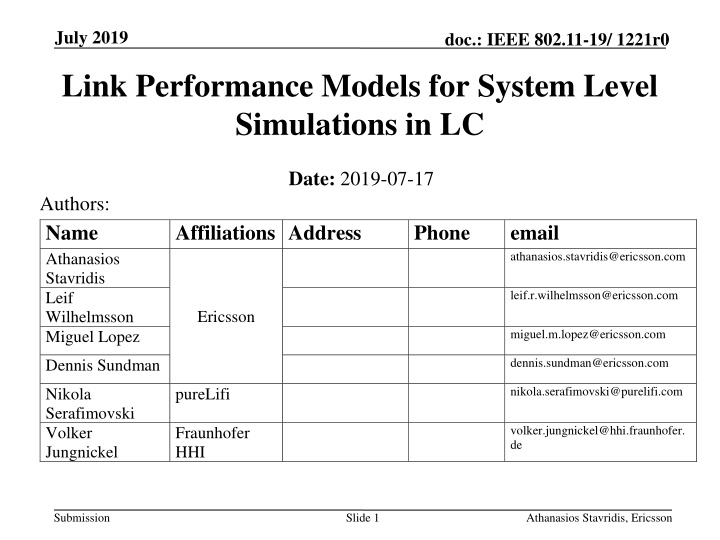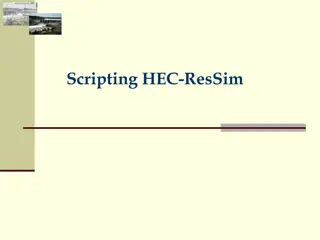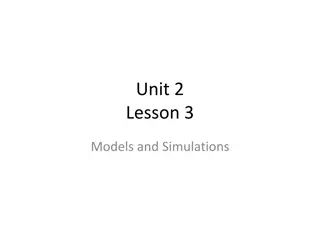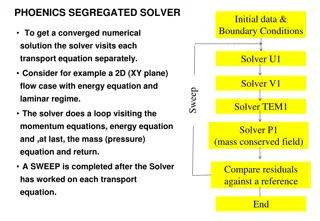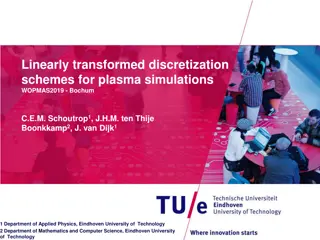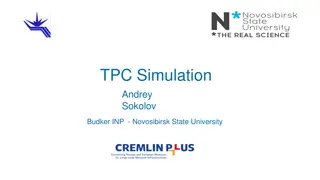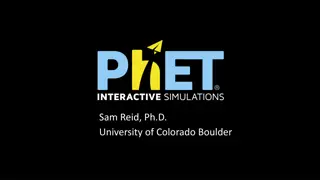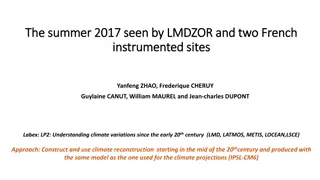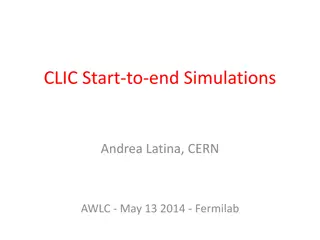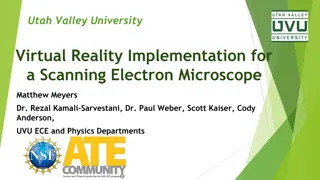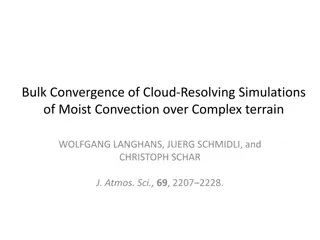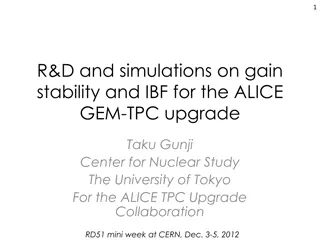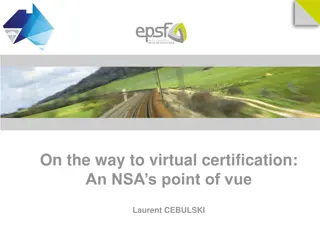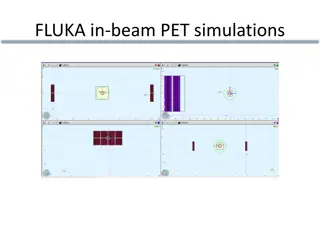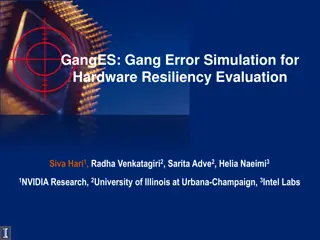Link Performance Models for System Level Simulations in LC
This presentation outlines an efficient approach for obtaining system level simulation results using a PHY layer abstraction, focusing on OFDM-based systems and accurate mapping of SINRs to improve computational efficiency. The methodology described aims to accelerate system level simulations by assuming PHY layer abstractions, as extensively used in IEEE 802.11 standards.
Uploaded on Mar 19, 2025 | 1 Views
Download Presentation

Please find below an Image/Link to download the presentation.
The content on the website is provided AS IS for your information and personal use only. It may not be sold, licensed, or shared on other websites without obtaining consent from the author.If you encounter any issues during the download, it is possible that the publisher has removed the file from their server.
You are allowed to download the files provided on this website for personal or commercial use, subject to the condition that they are used lawfully. All files are the property of their respective owners.
The content on the website is provided AS IS for your information and personal use only. It may not be sold, licensed, or shared on other websites without obtaining consent from the author.
E N D
Presentation Transcript
July 2019 doc.: IEEE 802.11-19/ 1221r0 Link Performance Models for System Level Simulations in LC Date: 2019-07-17 Authors: Name Athanasios Stavridis Leif Wilhelmsson Miguel Lopez Affiliations Address Phone email athanasios.stavridis@ericsson.com leif.r.wilhelmsson@ericsson.com Ericsson miguel.m.lopez@ericsson.com dennis.sundman@ericsson.com Dennis Sundman nikola.serafimovski@purelifi.com Nikola Serafimovski Volker Jungnickel pureLifi volker.jungnickel@hhi.fraunhofer. de Fraunhofer HHI Submission Slide 1 Athanasios Stavridis, Ericsson
July 2019 doc.: IEEE 802.11-19/ 1221r0 Abstract The objective of this presentation is to describe an efficient approach for obtaining system level simulation results using a PHY layer abstraction in a timely and computationally efficient fashion. The considered approach is focused on an OFDM-based system and relies on the accurate mapping of the SINRs of the used sub-carriers during an OFDM symbol to an effective SINR denoted as ???????. The ??????? accurately captures/approximates the PER performance metric based on a predetermined table which maps the ??????? to a value of PER for a AWGN channel. Submission Slide 2 Athanasios Stavridis, Ericsson
July 2019 doc.: IEEE 802.11-19/ 1221r0 Outline Introduction A Generic System Level Simulator A Generic Link Level Simulator Calculation of the SINReff Model Functions An Approach for Using the CESM method in LC An Approach for Using the MIESM method in LC Why the EESM Approach is Directly Applicable to LC Conclusions Submission Slide 3 Athanasios Stavridis, Ericsson
July 2019 doc.: IEEE 802.11-19/ 1221r0 Introduction (1) The complete characterization of the performance of a LC system involves both link and system level simulation results. In a link level simulator, the performance of a transceiver (or a small number of transceivers) is obtained by considering a detailed description of the underlying PHY layer architecture. This is undertaken for a number of channel realizations. In contrasts, a system level simulator produces results that characterize the whole system performance of a network of Access Points (APs) serving a large number of STAs assuming a holistic approach. In practice, a metrics, such as AP throughput, for multiple APs (with multiple transceivers) are produced for the whole system performance characterization. Submission Slide 4 Athanasios Stavridis, Ericsson
July 2019 doc.: IEEE 802.11-19/ 1221r0 Introduction (2) Clearly, the complete link level performance characterization of the multiple transceivers of a system level simulator is only possible via massive computational resources in a lengthy process. Thus, an accurate abstraction of the link level performance is required for reducing the required computational and time resources in a system level simulator. The presented approach has been used extensively from IEEE 802.11. The most recent example is the Mutual Information Effective SINR Metric (MIESM) method used for the evaluation of 802.11ax [1]. The rest of this contribution aims to provide a methodology for accelerating the system level simulations of a LC system by assuming PHY layer abstractions. Submission Slide 5 Athanasios Stavridis, Ericsson
July 2019 doc.: IEEE 802.11-19/ 1221r0 A Generic System Level Simulator In [3], the following schematic for an RF dynamic system level simulator is presented: Connection between the link and system level simulators Submission Slide 6 Athanasios Stavridis, Ericsson
September 2018 doc.: IEEE 802.11-19/ 1221r0 A Generic Link Level Simulator In [3], the following general performance model for RF communication has been adopted: A model for LC needs to consider only the characteristics of an optical channel. In an OFDM-based system, a natural selection for the quantities of ??, ? = 1, ,? is the SINR? per subcarrier. Consequently, the effective SINReff can be also a natural selection for the result of a compression process. Submission Slide 7 Athanasios Stavridis, Ericsson
July 2019 doc.: IEEE 802.11-19/ 1221r0 Calculation of the Effective ??????? The most common approach in literature expresses the SINReff as [2,3]: ? SINR? ? 1 ? ?=1 SINReff= ?I 1 I , where: I . is a model specific function I 1. is the inverse of I ? and ? are parameters that allow the model adaption to consider MCS (modulation coding scheme.) Submission Slide 8 Athanasios Stavridis, Ericsson
July 2019 doc.: IEEE 802.11-19/ 1221r0 Model Functions In literature, the following model functions have been considered for RF communication: Name Acronym CESM Formula Capacity Effective SINR Metric Exponential Effective SINR Metric Mutual Information Effective SINR Metric I = log21 + ? I = e ? EESM MIESM I = ??(?) Obviously, the use of CESM and MIESM in LC needs to consider the special characteristics of the wireless optical channel. In addition, in MIESM approach further details, such that the type of coding, reception method, etc, of the considered PHY needs to be taken into account. Submission Slide 9 Athanasios Stavridis, Ericsson
July 2019 An Approach for using the CESM method in LC From [4], the following bounds can be used assuming an average power constraint, ?, and peak power constraint, (including the LC channel). For, 0 < ? <1 doc.: IEEE 802.11-19/ 1221r0 2 , where, ? =? 2log 1 + ?2?2?? : 1 ?? ? ? ?, 1 2???2 ?2 ?2 ? ?, 1 2log 1 + ? 1 ? ? ? 1 ? ? 1 ? ? is the unique solution of ? = For, 1 2 ? 1: ? ?, 1 ?2 2log 1 + 2???2 ?2 4?2 ? ?, 1 2log 1 + ?2 is the variance of a zero mean Gaussian random variable (thermal and ambient noise). Submission Slide 10 Athanasios Stavridis, Ericsson
July 2019 doc.: IEEE 802.11-19/ 1221r0 An Approach for using the MIESM method in LC In [4], the mutual information is bounded assuming an average power constraint, ?, and peak power constraint, , (when the optical channel is considered) as: ? ?;? 1 2log 1 +?2 ? is the differential entropy and ??(?) the 2???2. Here, ? = E log ??(?) probability density function (PDF) of ?. In [4], the provided capacity bounds are derived assuming different suboptimal PDFs for ? (channel input). Thereover, if ? ?;? , as given before, is used for quantifying (lower bounding) the mutual information, the results obtained with CESM and MIESM will be the same for the same selection of PDFs of ?. A alternative approach is to use the mutual information per coded bit by considering a specific Modulation and Coding Scheme (MCS) and reception type. Submission Slide 11 Athanasios Stavridis, Ericsson
July 2019 Why the EESM Approach is Directly Applicable to LC The derivation of the SINReff for the EESM approach is based on the [2,5]: Chernoff bound Union bound method for calculating the error probability of coded transmission. doc.: IEEE 802.11-19/ 1221r0 Using the previous basis, the authors of [2,5] express the calculations of the SINReff as: ? SINR? amac 1 ? ?=1 SINReff= amacln ? , where, am, and, ac, are adjusting factors for the ?-ary constellation and coding rate, respectively. Clearly, the previous steps are directly applicable to any intensity modulation scheme and thus to LC. Submission Slide 12 Athanasios Stavridis, Ericsson
July 2019 doc.: IEEE 802.11-19/ 1221r0 Conclusions The time acceleration and computational simplification of the heavy system level simulations of a LC system can be done via the PHY layer abstraction. In this contribution, the well known methods for PHY abstraction, CESM, EESM, and MIESM were presented. It was concluded that only the methods of EESM can be directly migrated from the evaluation of an RF system to the evaluation of a LC system. The evaluation of a LC system using the methods of CESM and MIESM requires the careful use of the corresponding information-theoretic results for LC. Submission Slide 13 Athanasios Stavridis, Ericsson
July 2019 doc.: IEEE 802.11-19/ 1221r0 References [1] 802.11-14/0571r12, 11ax Evaluation Methodology , Ron Porat, et al. [2] Lei Wan, Shiauhe Tsai and M. Almgren, "A fading-insensitive performance metric for a unified link quality model," IEEE Wireless Communications and Networking Conference, 2006, Las Vegas, NV. [3] K. Brueninghaus et al., "Link performance models for system level simulations of broadband radio access systems," 2005 IEEE 16th International Symposium on Personal, Indoor and Mobile Radio Communications, Berlin, 2005. [4] A. Lapidoth, S. M. Moser and M. A. Wigger, "On the Capacity of Free-Space Optical Intensity Channels," in IEEE Trans. on Information Theory, vol. 55, no. 10, pp. 4449-4461, Oct. 2009. [5] Ericsson, Effective-SNR Mapping for Modeling Frame Error Rates in Multiple-State Channels , 3GPP2-C30-20030429-010 Submission Slide 14 Athanasios Stavridis, Ericsson
